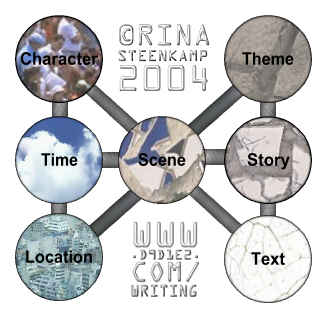
I'm writing a novel, the first draft of which can be found elsewhere on the site. Over here you'll find my thoughts about writing.
At the end of last year I took a class in creative writing. While doing that I began to realise that taking the class was a necessary step forwards - I felt I had come a long way since I had started working on the novel, but that I was reaching the limit of what I could learn that way.
Another realisation came when I tried to continue working on the story at the beginning of this year: I found I needed more structure. With the first draft of the novel getting near the 50,000 words mark I was finding it difficult to still hold the complete story in my head, keep track of who did what when, and follow up on all the little threads I've woven into the story's fabric. Since I expect the completed first draft to clock in at 100,000+ words, and since in my mind the two sequels are becoming more and more of a reality, this is something I need to address.
When I started working on the novel, I had this idea that the work on the first draft would be purely intuitive stream-of-consciousness, which is what I have been doing, and that with the second draft my analytical side would get free rein. I would take the story apart, examine all the elements, improve where necessary, and build the second draft from there. I didn't actually have a clue how to do this, but I decided I would worry about that later.
In a strange way working on the novel has been an exercise in faith, since answers seem to appear when I need them. In this case, it happened when watching the documentaries on the extended edition of The Two Towers. (Since it was seeing the movie that got me started writing the novel, I should probably include a nice thank you note to the good folks who made the movie if and when the novel ever gets published.)
And the answer looked like this:

As I saw it, at the heart of the story is the scene.
For the reader, the novel is a sequence of scenes, conveyed through text. In the course of each scene he or she needs to be able to understand what's going on, who's doing what, and where the scene is taking place. The story as a whole needs to enable the reader to come to an understanding of who the characters are, why they do what they're doing, what's happening to them and why. The story also needs to be constructed in such a way that the reader is compelled to read on, and rewarded for doing so.
For me, as a writer, the scene is the basic unit of work. The idea of doing a second draft intitially baffled me, since going to the full text of the first draft and making changes as needed didn't seem that different from what I'd been doing with the first draft. I now feel that what I need to do is to take my first draft and break it up into scenes. I can then look at each scene separately and start asking questions like 'how does this scene move the story forward?' 'is there a clear transition from the previous scene, and does the reader understand what's going on?' 'do I understand why the characters do what they do?' etc.
(Odd - whenever I need to figure something out I start drawing diagrams, but still the only way for me to work on the first draft of the novel is to start writing and see what happens.)
This article was written after writing episode 73 of the first draft of my novel After the War.
![]() After the War (73)
After the War (73)
On this page Transitional HTML 4.01 and CSS 1 are used. If you're seeing this text you either have CSS switched off in your browser, or you're using a browser that can't handle CSS. If you're using an older browser version, you might want to consider upgrading.